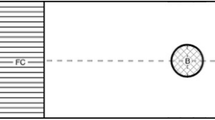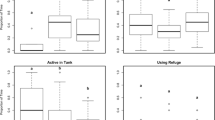Abstract
Sea lampreys Petromyzon marinus, an invasive pest in the Upper Great Lakes, avoid odours that represent danger in their habitat. These odours include conspecific alarm cues and predator cues, like 2-phenylethylamine hydrochloride (PEA HCl), which is found in the urine of mammalian predators. Whether conspecific alarm cues and predator cues function additively or synergistically when mixed together is unknown. The objectives of this experimental study were to determine if the avoidance response of sea lamprey to PEA HCl is proportional to the concentration delivered, and if the avoidance response to the combination of a predator cue (PEA HCl) and sea lamprey alarm cue is additive. To accomplish the first objective, groups of ten sea lampreys were placed in an artificial stream channel and presented with stepwise concentrations of PEA HCl ranging from 5 × 10−8 to 5 × 10−10 M and a deionized water control. Sea lampreys exhibited an increase in their avoidance behaviour in response to increasing concentrations of PEA HCl. To accomplish the second objective, sea lampreys were exposed to PEA HCl, conspecific alarm cue and a combination of the two. Sea lampreys responded to the combination of predator cue and conspecific alarm cue in an additive manner.


Similar content being viewed by others
References
Alexander Jr, J. E. & A. P. Covich, 1991. Predator avoidance by the freshwater snail Physella virgata in response to the crayfish Procambarus simulans. Oecologia 87: 435–442.
Bals, J. D. & M. Wagner, 2012. Behavioral responses of sea lamprey (Petromyzon marinus) to a putative alarm cue derived from conspecific and heterospecific sources. Behaviour 149: 901–923.
Binder, T. R. & D. G. McDonald, 2007. Is there a role for vision in the behaviour of sea lampreys (Petromyzon marinus) during their upstream spawning migration? Canadian Journal of Fisheries and Aquatic Sciences 64: 1403–1412.
Brege, D. C., D. M. Davis, J. H. Genovese, T. C. McAuley, B. E. Stephens & R. W. Westman, 2003. Factors responsible for the reduction in quantity of the lampricide, TFM, applied annually in streams tributary to the Great Lakes from 1979 to 1999. Journal of Great Lakes Research 29: 500–509.
Brown, G. E., 2003. Learning about danger: chemical alarm cues and local risk assessment in prey fishes. Fish and Fisheries 4: 227–234.
Brown, G. E. & R. J. F. Smith, 1996. Foraging trade-offs in fathead minnows (Pimephales promelas, Osteichthyes, Cyprinidae): acquired predator recognition in juvenile rainbow trout (Oncorhynchus mykiss): conditioning hatchery-reared fish to recognize chemical cues of a predator. Ethology 102: 776–785.
Brown, G. E. & G. Magnavacca, 2003. Predator inspection behaviour in a characin fish: an interaction between chemical and visual information? Ethology 109: 739–750.
Brown, G. E., J. C. Adrian Jr, T. Patton & D. P. Chivers, 2001. Fathead minnows learn to recognize predator odour when exposed to concentrations of artificial alarm pheromone below their behavioural-response threshold. Canadian Journal of Zoology 79: 2239–2245.
Brown, G. E., J.-F. Poirier & J. Adrian, 2004. Assessment of local predation risk: the role of subthreshold concentrations of chemical alarm cues. Behavioral Ecology 15: 810–815.
Brown, G. E., M. C. O. Ferrari, & D. P. Chivers, 2011. Learning about danger: chemical alarm cues and threat-sensitive assessment of predation risk by fishes. In Brown, C., K. Laland, & J. Krause (eds), Fish Cognition and Behavior, Oxford: 56–80.
Commission, Great Lakes Fishery, 2011. Strategic Vision of the Great Lakes Fishery Commission 2011-2020. Great Lakes Fishery Commission, Ann Arbor.
Cook, S. M., Z. R. Khan & J. A. Pickett, 2007. The use of push-pull strategies in integrated pest management. Annual Review of Entomology 52: 375–400.
Di Rocco, R. T., C. F. Belanger, I. Imre, G. E. Brown & N. S. Johnson, 2014. Daytime avoidance of chemosensory alarm cues by adult sea lamprey (Petromyzon marinus). Canadian Journal of Fisheries and Aquatic Sciences 71: 824–830.
Ferrari, M. C. O., J. J. Trowell, G. E. Brown & D. P. Chivers, 2005. The role of learning in the development of threat-sensitive predator avoidance by fathead minnows. Animal Behaviour 70: 777–784.
Ferrari, M. C. O., M. A. Vavrek, C. K. Elvidge, B. Fridman, D. P. Chivers & G. E. Brown, 2008. Sensory complementation and the acquisition of predator recognition by salmonid fishes. Behavioral Ecology and Sociobiology 63: 113–121.
Ferrari, M. C. O., B. D. Wisenden & D. P. Chivers, 2010. Chemical ecology of predator–prey interactions in aquatic ecosystems: a review and prospectus. Canadian Journal of Zoology 88: 698–724.
Ferrero, D. M., J. K. Lemon, D. Fluegge, S. L. Pashkovski, W. J. Korzan, S. R. Datta, M. Spehr, M. Fendt & S. D. Liberles, 2011. Detection and avoidance of a carnivore odor by prey. Proceedings of the National Academy of Science of the United States of America 108: 11235–11240.
Helfman, G. S., 1989. Threat-sensitive predator avoidance in damselfish-trumpetfish interactions. Behavioral Ecology and Sociobiology 24: 47–58.
Holmes, T. H. & M. I. McCormick, 2011. Response across a gradient: behavioural reactions of newly settled fish to predation cues. Animal Behaviour 81: 543–550.
Hume, J. B., T. D. Meckley, N. S. Johnson, T. M. Luhring, M. J. Siefkes & C. M. Wagner, 2015. The application of an alarm cue in a push-pull configuration hastens arrival of invasive sea lamprey (Petromyzon marinus) at a trapping location. Canadian Journal of Fisheries and Aquatic Sciences. doi:10.1139/cjfas-2014-0535.
Imre, I., G. E. Brown, R. A. Bergstedt & R. B. McDonald, 2010. Use of chemosensory cues as repellents for sea lamprey: potential directions for population management. Journal of Great Lakes Research 36: 790–793.
Imre, I., R. T. Di Rocco, C. F. Belanger, G. E. Brown & N. S. Johnson, 2014. The behavioural response of adult Petromyzon marinus to damage-released alarm and predator cues. Journal of Fish Biology 84: 1490–1502.
Jacobsen, H. P. & O. B. Stabell, 2004. Antipredator behaviour mediated by chemical cues: the role of conspecific alarm signalling and predator labelling in the avoidance response of a marine gastropod. Oikos 104: 43–50.
Johnson, N. S., S.-S. Yun, H. T. Thompson, C. O. Brant, W. Li & J. Meinwald, 2009. A synthesized pheromone induces upstream movement in female sea lamprey and summons them into traps. Proceedings of the National Academy of Science of the United States of America 106: 1021–1026.
Johnson, N. S., M. J. Siefkes, M. Wagner, H. Dawson, H. Wang, T. Steeves, M. B. Twohey & W. Li, 2013. A synthesized mating pheromone component increases adult sea lamprey (Petromyzon marinus) trap capture in management scenarios. Canadian Journal of Fisheries and Aquatic Sciences 70: 1101–1108.
Kats, L. B. & L. M. Dill, 1998. The scent of death: chemosensory assessment of predation risk by prey animals. Ecoscience 5: 361–394.
Kircheis, F. W., 2004. Sea Lamprey. FW Kircheis LLC, Carmel.
Kusch, R. C., R. S. Mirza & D. P. Chivers, 2004. Making sense of predator scents: investigating the sophistication of predator assessment abilities of fathead minnows. Behavioral Ecology and Sociobiology 55: 551–555.
Li, W., P. W. Sorensen & D. D. Gallaher, 1995. The olfactory system of migratory adult sea lamprey (Petromyzon marinus) is specifically and acutely sensitive to unique bile acids released by conspecific larvae. The Journal of general physiology 105: 569–587.
Li, W., A. P. Scott, M. J. Siefkes, H. Yan, Q. Liu, S.-S. Yun & D. A. Gage, 2002. Bile acid secreted by male sea lamprey that acts as a sex pheromone. Science American Association for the Advancement of Science 296: 138–141.
Libants, S., K. Carr, H. Wu, J. H. Teeter, Y.-W. Chung-Davidson, Z. Zhang, C. Wilkerson & W. Li, 2009. The sea lamprey Petromyzon marinus genome reveals the early origin of several chemosensory receptor families in the vertebrate lineage. BMC Evolutionary Biology 9: 180.
Lima, S. L. & T. D. Steury, 2005. Perception of predation risk: the foundation of nonlethal predator-prey interactions. In Barbosa, P. & I. Castellanos (eds), Ecology of Predator-Prey Interactions. Oxford University Press, Oxford: 166–188.
Lotze, J. H., & A. I. Fleischman, 1978. The raccoon (Procyon lotor) on St. Catherines Island, Georgia. 1. Biochemical parameters of urine and blood serum. American Museum novitates: 1–5.
McCormick, M. I. & R. Manassa, 2007. Predation risk assessment by olfactory and visual cues in a coral reef fish. Coral Reefs 27: 105–113.
McLaughlin, R. L., A. Hallett, T. C. Pratt, L. M. O’Connor & D. G. McDonald, 2007. Research to guide use of barriers, traps, and fishways to control sea lamprey. Journal of Great Lakes Research 33: 7–19.
Mikheev, V. N., J. Wanzenbock & A. F. Pasternak, 2006. Effects of predator-induced visual and olfactory cues on 0+ perch (Perca fluviatilis L.) foraging behaviour. Ecology of Freshwater Fish 15: 111–117.
Preisser, E. L., D. I. Bolnick & M. E. Benard, 2005. Scared to death? The effects of intimidation and consumption in predator-prey interactions. Ecology Ecological Society of America 86: 501–509.
Schoeppner, N. M. & R. A. Relyea, 2005. Damage, digestion, and defence: the roles of alarm cues and kairomones for inducing prey defences. Ecology Letters 8: 505–512.
Scott, W. B. & E. J. Crossman, 1998. Freshwater Fishes of Canada. Galt House Publications Ltd., Oakville.
Siefkes, M. J., R. A. Bergstedt, M. B. Twohey & W. Li, 2003. Chemosterilization of male sea lampreys (Petromyzon marinus) does not affect sex pheromone release. Canadian Journal of Fisheries and Aquatic Sciences 60: 23–31.
Smith, B. R. & J. J. Tibbles, 1980. Sea lamprey (Petromyzon marinus) in Lakes Huron, Michigan, and superior: history of invasion and control, 1936-1978. Canadian Journal of Fisheries and Aquatic Sciences 37: 1780–1801.
StatSoft Inc, 2015. STATISTICA (data analysis software system) version 12.5 [available on internet at www.statsoft.com].
von Frisch, K., 1941. Über einen Schreckstoff der Fischhaut und seine biologische Bedeutung. Zeitschrift für vergleichende Physiologie 29: 46–145.
Wagner, M., E. M. Stroud, T. D. Meckley & C. Kraft, 2011. A deathly odor suggests a new sustainable tool for controlling a costly invasive species. Canadian Journal of Fisheries and Aquatic Sciences 68: 1157–1160.
Ward, A. J. W. & T. Mehner, 2010. Multimodal mixed messages: the use of multiple cues allows greater accuracy in social recognition and predator detection decisions in the mosquitofish, Gambusia holbrooki. Behavioral Ecology 21: 1315–1320.
Warton, D. I. & F. K. C. Hui, 2011. The arcsine is asinine: the analysis of proportions in ecology. Ecology 92: 3–10.
Wisenden, B. D., 2003. Chemically mediated strategies to counter predation. In Collin, S. P. & N. J. Marshall (eds), Sensory Processing in Aquatic Environments. Springer New York, New York: 236–251.
Wisenden, B. D. & D. P. Chivers, 2006. The role of public chemical information in antipredator behaviour. In Ladich, F., S. P. Colins, P. Moller & B. G. Kapoor (eds), Fish Chemoreception. Enfield, N.H.: 259–278.
Acknowledgments
We would like to thank Dr. Michael Hansen and the employees of the Hammond Bay Biological Station for their assistance. We would like to specifically thank A. Miehls for loaning us St. Marys sea lampreys to complete this experiment, E. Larson for his assistance in configuring and maintaining our holding tanks, and K. Slaght for help in the laboratory. We are grateful to S. Miehls and G. Bravener for coordinating the delivery of experimental subjects. Feedback from J.W.A. Grant, C.O. Brant and two anonymous reviewers greatly improved this manuscript. Finally, we would like to thank H. McClure and E. Jordbro for their hard work in the stream channels and analyzing videos. The Great Lakes Fishery Commission provided funding for this research. Concordia International generously provided financial assistance to R. Di Rocco to conduct this research. This manuscript is contribution number 1935 of the Great Lakes Science Center. Mention of trademark names does not infer endorsement by the US Federal Government.
Author information
Authors and Affiliations
Corresponding author
Additional information
Handling editor: Lee B. Kats
Rights and permissions
About this article
Cite this article
Di Rocco, R.T., Imre, I., Johnson, N.S. et al. Behavioural response of adult sea lamprey (Petromyzon marinus) to predator and conspecific alarm cues: evidence of additive effects. Hydrobiologia 767, 279–287 (2016). https://doi.org/10.1007/s10750-015-2508-6
Received:
Revised:
Accepted:
Published:
Issue Date:
DOI: https://doi.org/10.1007/s10750-015-2508-6




